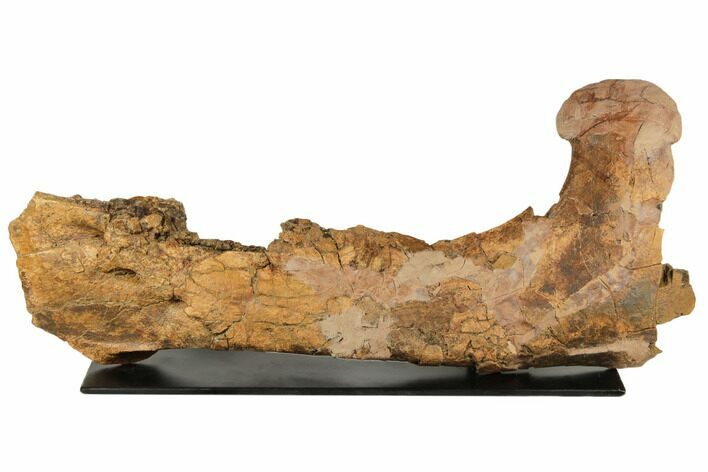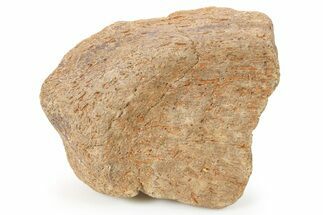This Specimen has been sold.
21.6" Triceratops Mandible (Lower Jaw) On Stand - Wyoming
This is a 21.6" wide mandible bone of a marginocephalian (likely Triceratops horridus) from the Late Cretaceous, or roughly 66 million year old Lance Creek Formation of Wyoming. It was found heavily fractured and fragmented within the rock, requiring significant restoration and crack repair throughout. The head of the mandible has been completely restored, with gap fill restoration continuing through the ramus and down across the body. The restoration in the specimen is hard to miss and can be identified by its smooth texture. A neat feature of this specimen is the preserved foramen that would have housed blood vessels and nerves. These can be found along the distal end of the mandible on the labial side.
This specimen is lacking preservation detail, making it difficult to give an accurate species identification. However, based on size and abundance, it's very likely to be from Triceratops horridus.
It comes with a metal display stand.
This specimen is lacking preservation detail, making it difficult to give an accurate species identification. However, based on size and abundance, it's very likely to be from Triceratops horridus.
It comes with a metal display stand.
About Triceratops
Triceratops is one of the most recognized and intriguing of the North American ceratopsid dinosaurs. They stomped around the Late Cretaceous (around 68-66 mya), brandishing their three-pronged and bony frilled skulls, chewing on fibrous plants. They struggled against large predators, stood their ground, and tried not to be devoured by the ferocious Tyrannosaurus rex.
The head on a Triceratops may have been an intimidating show rather than a stabbing, defensive trident and imposing shield for inter-species jousting. Researchers have given close scrutiny to the holes, or fenestrae, of other ceratopsid crests. In the past, the holes within the shield were used to confirm separate species.
Individual Triceratops are estimated to have reached up to 9 meters (29.5 feet) in length, 3 meters (9.8 feet) in height, and weighed up to 26,000 pounds. The largest known skull is estimated to have been 2.5 meters (8.2 feet) long and would have extended almost a third of the length of the mature individual. The pointed horns were approximately 1 meter (3 feet) long. With its sturdy build and powerful legs, Triceratops could have ripped open the predator that wanted this herbivore for dinner.
One of the most abundant of the large Cretaceous fauna, Triceratops plucked low growth with its beak-tipped jaws. Triceratops teeth were arranged in groups, called batteries, of 36 to 40 tooth columns, in each side of each jaw. Each column contained about 3 to 5 stacked teeth, depending on the individual’s size. This produced a range of 432 to 800 teeth, of which only a fraction were in use at any given time (due to tooth replacement). The great size and quantity of teeth suggests that they ate large volumes of fibrous plants. These were possibly palms, cycads, and ferns.
Triceratops was designated as the state fossil of South Dakota in 1988.
Triceratops is one of the most recognized and intriguing of the North American ceratopsid dinosaurs. They stomped around the Late Cretaceous (around 68-66 mya), brandishing their three-pronged and bony frilled skulls, chewing on fibrous plants. They struggled against large predators, stood their ground, and tried not to be devoured by the ferocious Tyrannosaurus rex.
The head on a Triceratops may have been an intimidating show rather than a stabbing, defensive trident and imposing shield for inter-species jousting. Researchers have given close scrutiny to the holes, or fenestrae, of other ceratopsid crests. In the past, the holes within the shield were used to confirm separate species.
Individual Triceratops are estimated to have reached up to 9 meters (29.5 feet) in length, 3 meters (9.8 feet) in height, and weighed up to 26,000 pounds. The largest known skull is estimated to have been 2.5 meters (8.2 feet) long and would have extended almost a third of the length of the mature individual. The pointed horns were approximately 1 meter (3 feet) long. With its sturdy build and powerful legs, Triceratops could have ripped open the predator that wanted this herbivore for dinner.
One of the most abundant of the large Cretaceous fauna, Triceratops plucked low growth with its beak-tipped jaws. Triceratops teeth were arranged in groups, called batteries, of 36 to 40 tooth columns, in each side of each jaw. Each column contained about 3 to 5 stacked teeth, depending on the individual’s size. This produced a range of 432 to 800 teeth, of which only a fraction were in use at any given time (due to tooth replacement). The great size and quantity of teeth suggests that they ate large volumes of fibrous plants. These were possibly palms, cycads, and ferns.
Triceratops was designated as the state fossil of South Dakota in 1988.
SPECIES
Triceratops horridus
LOCATION
Wyoming
FORMATION
Lance Creek Formation
SIZE
21.6 x 9.4"
CATEGORY
SUB CATEGORY
ITEM
#192545
We guarantee the authenticity of all of our specimens.
 Reviews
Reviews



















